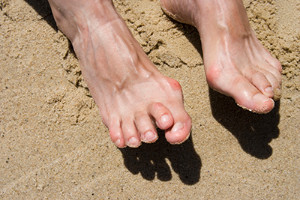Blog
Items filtered by date: May 2024
Why Some People Get Hammertoes

Hammertoes are a deformity where the toe bends at the middle joint, causing the tip to curl downward, resembling a hammer. This condition can affect any of the smaller toes and is categorized into flexible hammertoes, which are still movable at the joint. Rigid hammertoes are defined as tight tendons causing the joint to become misaligned and immobile. Hammertoes develop over time, often due to wearing ill-fitting shoes that squeeze the toes or cause them to bend. High heels or narrow shoes are common culprits. Genetics, certain diseases like arthritis, and trauma can also contribute to their formation. People with unusually long toes, flat feet, or high arches are more susceptible. Diagnosis typically involves a physical examination, and in some cases, X-rays to assess the extent of the deformity. Treatment options range from changes in footwear and custom orthotic devices to surgery in severe cases. If you have a hammertoe that is causing you discomfort, it is suggested that you visit a podiatrist for an accurate diagnosis and treatment options.
Hammertoes can be a painful condition to live with. For more information, contact Dr. Dean D. Hinners of Illinois. Our doctor will answer any of your foot- and ankle-related questions.
Hammertoe
Hammertoe is a foot deformity that occurs due to an imbalance in the muscles, tendons, or ligaments that normally hold the toe straight. It can be caused by the type of shoes you wear, your foot structure, trauma, and certain disease processes.
Symptoms
- Painful and/or difficult toe movement
- Swelling
- Joint stiffness
- Calluses/Corns
- Physical deformity
Risk Factors
- Age – The risk of hammertoe increases with age
- Sex – Women are more likely to have hammertoe compared to men
- Toe Length – You are more likely to develop hammertoe if your second toe is longer than your big toe
- Certain Diseases – Arthritis and diabetes may make you more likely to develop hammertoe
Treatment
If you have hammertoe, you should change into a more comfortable shoe that provides enough room for your toes. Exercises such as picking up marbles may strengthen and stretch your toe muscles. Nevertheless, it is important to seek assistance from a podiatrist in order to determine the severity of your hammertoe and see which treatment option will work best for you.
If you have any questions, please feel free to contact one of our offices located in Metropolis and Eldorado, IL . We offer the newest diagnostic and treatment technologies for all your foot care needs.
Strategies for Preventing Falls

Preventing falls among older adults is paramount to maintaining quality of life and independence. Various factors contribute to an increased risk of falls in seniors. Among them are muscle weakness, gait abnormalities, and pain. Additionally, certain health conditions like inner ear problems, vision impairment, and arthritis can negatively affect balance and mobility. Medications, such as those for blood pressure and sleep disorders, can induce side effects that increase susceptibility to falls. Through comprehensive assessments and evaluations, a podiatrist can tailor interventions to reduce fall risks. These may involve strength, gait, and balance tests, blood pressure monitoring and vision assessments. Incorporating balance exercises and strength training into daily routines can significantly enhance mobility and stability, thereby reducing the likelihood of falls. Activities targeting core and leg muscles are particularly beneficial, as they play a vital role in maintaining balance and coordination. Using assistive devices, such as canes, walkers or wheelchairs, can provide additional support and safety for individuals with mobility limitations. If you are a senior and have fallen recently or experience balance problems, it is suggested that you schedule an appointment with a podiatrist for a thorough exam to determine what the reason is.
Preventing falls among the elderly is very important. If you are older and have fallen or fear that you are prone to falling, consult with Dr. Dean D. Hinners from Illinois. Our doctor will assess your condition and provide you with quality advice and care.
Every 11 seconds, an elderly American is being treated in an emergency room for a fall related injury. Falls are the leading cause of head and hip injuries for those 65 and older. Due to decreases in strength, balance, senses, and lack of awareness, elderly persons are very susceptible to falling. Thankfully, there are a number of things older persons can do to prevent falls.
How to Prevent Falls
Some effective methods that older persons can do to prevent falls include:
- Enrolling in strength and balance exercise program to increase balance and strength
- Periodically having your sight and hearing checked
- Discuss any medications you have with a doctor to see if it increases the risk of falling
- Clearing the house of falling hazards and installing devices like grab bars and railings
- Utilizing a walker or cane
- Wearing shoes that provide good support and cushioning
- Talking to family members about falling and increasing awareness
Falling can be a traumatic and embarrassing experience for elderly persons; this can make them less willing to leave the house, and less willing to talk to someone about their fears of falling. Doing such things, however, will increase the likelihood of tripping or losing one’s balance. Knowing the causes of falling and how to prevent them is the best way to mitigate the risk of serious injury.
If you have any questions, please feel free to contact one of our offices located in Metropolis and Eldorado, IL . We offer the newest diagnostic and treatment technologies for all your foot care needs.
Facts and Care Guidelines Regarding Diabetic Foot Ulcers

Diabetic foot ulcers, a common complication of diabetes, are open wounds that develop on the feet or lower legs, often due to poor circulation, nerve damage, or trauma. These ulcers can be slow to heal and prone to infection, posing serious risks if left untreated. Proper care is essential for managing diabetic foot ulcers and preventing complications. Begin by keeping the ulcer clean and dry, washing it gently with mild soap and water, and patting it dry with a clean towel. Apply an antibiotic ointment and cover the ulcer with a sterile dressing to protect it from further injury and reduce the risk of infection. Avoid putting weight on the affected foot and wear comfortable, well-fitted shoes to minimize pressure on the ulcer. Regularly monitor the ulcer for signs of infection, such as redness, swelling, or pus. If you are a diabetic and foot ulcers are a problem, it is strongly suggested that you are under the care of a podiatrist who can effectively treat these foot wounds and help you manage your diabetes.
Wound care is an important part in dealing with diabetes. If you have diabetes and a foot wound or would like more information about wound care for diabetics, consult with Dr. Dean D. Hinners from Illinois. Our doctor will assess your condition and provide you with quality foot and ankle treatment.
What Is Wound Care?
Wound care is the practice of taking proper care of a wound. This can range from the smallest to the largest of wounds. While everyone can benefit from proper wound care, it is much more important for diabetics. Diabetics often suffer from poor blood circulation which causes wounds to heal much slower than they would in a non-diabetic.
What Is the Importance of Wound Care?
While it may not seem apparent with small ulcers on the foot, for diabetics, any size ulcer can become infected. Diabetics often also suffer from neuropathy, or nerve loss. This means they might not even feel when they have an ulcer on their foot. If the wound becomes severely infected, amputation may be necessary. Therefore, it is of the upmost importance to properly care for any and all foot wounds.
How to Care for Wounds
The best way to care for foot wounds is to prevent them. For diabetics, this means daily inspections of the feet for any signs of abnormalities or ulcers. It is also recommended to see a podiatrist several times a year for a foot inspection. If you do have an ulcer, run the wound under water to clear dirt from the wound; then apply antibiotic ointment to the wound and cover with a bandage. Bandages should be changed daily and keeping pressure off the wound is smart. It is advised to see a podiatrist, who can keep an eye on it.
If you have any questions, please feel free to contact one of our offices located in Metropolis and Eldorado, IL . We offer the newest diagnostic and treatment technologies for all your foot care needs.
Why Live with Pain and Numbness in Your Feet?
Understanding Footwear Needs of Children

Understanding the unique needs of growing children's feet is extremely important for selecting appropriate footwear. In the first year, a baby’s soft and supple feet with flexible bones require minimal covering. As they begin walking, arches develop, and muscles strengthen. Boys typically have larger and wider feet than girls, and during the first five years, the feet grow rapidly. This necessitates regular measurement and replacement of shoes as a child’s feet grow around half a size every few months. Children's shoes should offer rear foot cushioning, stability, and forefoot flexibility. Easy to use closures and moisture-wicking materials like mesh are optimal for comfort. While hand me downs can be economical, they are not recommended, because the shoes are molded to the previous wearer's feet and gait. Prompt replacement of outgrown shoes is vital to prevent discomfort or the development of foot issues. Additionally, it is best to avoid shoes that are either too small or too large. Consulting a podiatrist can provide valuable guidance on children's foot care and footwear selection. To check on the foot health of your child, it is suggested that you schedule an appointment with a podiatrist.
The health of a child’s feet is vital to their overall well-being. If you have any questions regarding foot health, contact Dr. Dean D. Hinners of Illinois. Our doctor can provide the care you need to keep you pain-free and on your feet.
Tips for Keeping Children's Feet Healthy
- Make sure their shoes fit properly
- Look for any signs of in-toeing or out-toeing
- Check to see if they have Clubfoot (condition that affects your child’s foot and ankle, twisting the heel and toes inward) which is one of the most common nonmajor birth defects.
- Lightly cover your baby’s feet (Tight covers may keep your baby from moving their feet freely, and could prevent normal development)
- Allow your toddler to go shoeless (Shoes can be restricting for a young child’s foot)
- Cut toenails straight across to avoid ingrown toenails
- Keep your child’s foot clean and dry
- Cover cuts and scrapes. Wash any scratches with soap and water and cover them with a bandage until they’ve healed.
If you have any questions, please feel free to contact one of our offices located in Metropolis and Eldorado, IL . We offer the newest diagnostic and treatment technologies for all your foot care needs.

